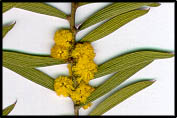South West Slopes Revegetation Guide
Acacia lanigera
Woolly Wattle
Select from the following for detailed images.
Species Information
| Synonyms |
|
| Common Names |
Woolly Wattle, Hairy Wattle |
| Family |
Mimosaceae - Mimosa family. |
| Name Origin |
lanigera - from Latin lana, wool, and gerus, bearing, referring to woolly hairs on 'leaves' and stems. |
Specimen Data - CSU 2078
| Location |
Holbrook Shire on Pulletop Road, on roadside near Billabong Creek NSW. |
| Notes |
Zone: 55 Easting: 527774 Northing: 6070749 |
| Collector |
Kent, Kylie |
Date |
08/09/2000 |
| Determined By |
Kent, Kylie |
Date |
25/09/2000 |
South West Slopes Revegetation Guide Information
| Regional: |
Noted on the drier hills of many catchments and districts, east of the Olympic Highway |
| Australia: |
NSW, Vic. |
| Habitat: |
Woodland and dry sclerophyll forest, on poor gravely and sandy soil. |
| Habit: |
Small erect or spreading shrub 50 cm to 3 m high, with rigid stems and 'leaves'. Grey bark and flattened or angled hairy branchlets. |
| Similar Species: |
|
| Site Preference: |
|
| Characteristics: |
Very long-lived. Moderate growth rate. Wasps form galls on flower buds in some areas. Conspicuous woody galls also caused by a fungus. |
| Flowering: |
Golden-yellow, usually Jul-Sept. |
| Seed Collection: |
Mid Nov to early Jan, when pods are brown and curled. Monitor closely as seeds released immediately or 1-2 days after maturity. |
| Propagation: |
From scarified seed. Pour boiling or very hot water over seeds and soak for several hours before sowing. |
| Regeneration: |
From seed, particularly after fire. Establishes moderately well when direct seeded. |
| Timber: |
|
| Shade and Shelter: |
Useful low-level cover in windbreaks. |
| Land Protection: |
Useful for stabilising soil and improving soil fertility. Legume - improves soil fertility by 'fixing' nitrogen. |
| Wildlife: |
Good habitat. Flowers are a pollen source for native moths, butterflies and other native insects, and a nectar-source for birds including honeyeaters. Insect-eating birds attracted. Native birds, including parrots and pigeons eat seeds. |
| Ornamental: |
Attractive ornamental for gardens, due to foliage and early flowering. Prune after |
| Other: |
|
Note: The following information presented is only a guide, as plant characteristics vary depending on provenance (the plant's locality).
| Site/Preferred Habitat : |
poor, well-drained soils |
| Rainfall(mm) : |
400-700 |
| Growth Rate : |
moderate |
| Tolerates : |
wetness for short periods |
| Resents : |
|
| Uses & Comments : |
windbreak; controlling erosion; fixes nitrogen; wildlife; ornamental |
Return to Database List
